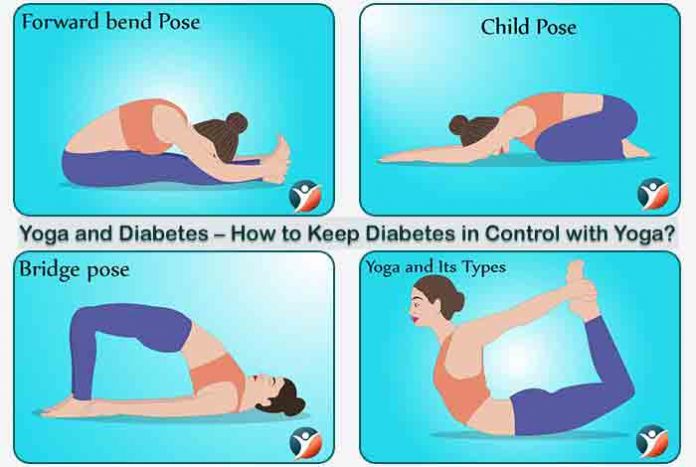
An increasing number of diabetics are now turning to yoga, to keep diabetes in control and improve their overall quality of life. While yoga is already known to reduce blood pressure, enhance mobility, alleviate stress and improve overall wellbeing, it is still not as popular for naturally managing diabetes. There are various yoga poses to manage diabetes. Let’s know more.
Nowadays, many health experts believe that yoga can help in diabetes management and significantly reduce risk of all the related complications. Read-on to know what magic yoga can bring in your life, that is otherwise in clutches of an intimidating life-long illness.
Table of Contents:
- Yoga and Its Types
- Health Benefits of Yoga
- How Can Yoga Help in Preventing and Managing Diabetes?
- How to Begin with Yoga, If You Have Diabetes?
- Yoga Poses for Managing Diabetes
- Conclusion
Yoga and Its Types

Yoga is a series of physical, mental and spiritual disciplines that originated in India, around 5000 years ago. Few people believe it to be even older than that. Yoga focuses on coordinating the breath, body and mind to induce a sense of calmness and inner peace. It involves myriad of postures and exercises which are known as asanas. These asanas along with meditation and breathing techniques promote mental composure and physical comfort.
Yoga can be classified into four major types
1. Viniyoga, Kripalu And Integral Yoga:
These yoga styles are generally recommended for anyone who wants to practice it in a gentle way. If you are unsure of which yoga style to pursue, you can choose any one of these styles.
2. Iyengar And Anusara Yoga:
These yoga styles are more active and focus greatly on body alignment.
Iyengar yoga emphasizes on precision, detail and alignment while performing any asana. So, if you are healthy and reasonably strong, you can begin with any one of these styles.
3. Ashtanga, Bikram, Power And Vinyasa Yoga:
These yoga styles are quite vigorous and are generally practised by people who are more athletic. Active and healthy young people, most commonly, prefer any one or more of these styles.
4. Restorative Yoga:
This yoga style is specifically designed for stress reduction and works effectively for all ability levels. It is advised to consult your doctor before you start on with any of these yoga types. Generally, diabetics can start with lighter yoga exercises such as breathing (pranayama). Keep reading to know various health benefits of yoga and about some exclusive yoga poses to manage diabetes.
Health Benefits of Yoga
Most of the people who indulge in yoga regularly, experience improvements in their physical and mental health. These health benefits include:
- Better sleep
- Reduced anxiety
- Feelings of well-being
- Improved digestion, immunity and blood circulation
- Improved strength, posture and flexibility
- Relief from various chronic illnesses
- Enhanced energy levels
- Improvement in concentration and focus
- Enhanced functioning and efficiency of neurological, respiratory and endocrine organs.
- Improved blood glucose levels
- Reduced high blood pressure
- Reduced asthma symptoms
- Reduced headaches
- Relief in lower back pain
- Reduced incidences of depression
We believe all these health benefits would encourage you to start practicing yoga or at-least start looking out for a yoga class near-by. Let’s learn how can yoga help you in both preventing and managing diabetes.
How Can Yoga Help in Preventing and Managing Diabetes?
Yoga is now considered a cost-effective and promising treatment for diabetes prevention and maintenance. Various studies have shown that yoga can provide relief in stress-related hyperglycemia and has a rather positive effect on blood glucose levels.
Stress management is one of the main aspects of managing diabetes. When we are constantly under stress, it increases our blood sugar. This increase in blood sugar can make a person more vulnerable to various health conditions including heart diseases.
Yoga and other breathing techniques including meditation help a person in invoking a relaxation response. This response in-turn regulates stress hormones including cortisol. Cortisol is responsible for increasing blood pressure and blood glucose levels. Both these health conditions play a major role in development of diabetes and its associated complications.
Besides treating diabetes, it can also help in preventing type-2 diabetes altogether. Let’s know how.
Rejuvenation of Pancreatic Cell:
Yoga asanas rejuvenate the pancreatic cells by gently stretching the pancreas. This in-turn can improve insulin’s production by stimulating insulin-producing beta cells.
Exercising Your Muscles:
Like all other forms of physical exercises, yoga can increase glucose uptake by the body’s muscular cells. This in-turn would reduce blood sugar level, improve blood circulation and reduce risk of various cardiovascular diseases.
Promoting Weight Loss:
Yoga helps in losing excess pounds and maintaining your weight thereafter. Keeping your weight in normal ranges can protect you against myriad of health conditions including cancer, type-2 diabetes and heart diseases.
Improving Your Mental Attitude:
Practicing yoga regularly can actually improve your focus. This would eventually help you in dealing with diabetes in a better way.
Above all, it can make you feel good!
While so many studies have actually proved yoga to be beneficial for diabetes, but it would be best to consult your doctor before you start on with your yoga journey. With this, we can discuss how to begin with yoga if you are a diabetic.
How to Begin with Yoga, If You Have Diabetes?
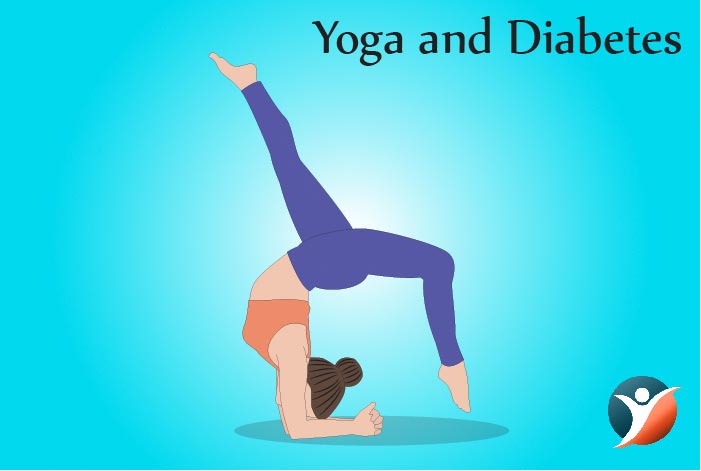
The best way to pick a yoga style for yourself, is to watch others and/or join a class. Before joining a yoga class, let your yoga teacher know about all your health concerns. During a class, stretch at your own comfort and pace. Don’t try any extreme movements and postures that you believe are beyond your abilities at that point of time. Pay attention to how you feel afterwards — light and refreshed or fatigued and weak. Obviously, latter is something you shouldn’t feel after a yoga class. If you feel really uncomfortable after a yoga session, you should know that particular yoga type isn’t a good idea for you.
If you are 45 or older, have lately been inactive, or have certain health concerns, you should start with Kripalu, Integral, Viniyoga or Restorative yoga.
Alternatively, you can start this healthy journey with help of online videos, health clubs, books, DVDs, magazines and friends. However, we advise you to practice yoga under guidance of an experienced, certified yoga trainer and after consultation with your doctor. Now that you are determined to start on with a healthy journey, let’s learn what to do and how.
Yoga Poses for Managing Diabetes:

Diabetes is generally caused when your body cells don’t respond to insulin. When you start practising yoga, your body starts responding to insulin. This in-turn helps in managing blood glucose levels. Yoga helps in improving blood circulation throughout the body especially arms and legs where issues are most encountered if you are a diabetic. Additionally, it helps in reducing stress at both physical and mental level which eventually helps in managing blood sugar.
Let’s get started with few amazing yoga poses to keep your diabetes in control.
1. Breathing (Pranayama):
Breathing in and out deeply can help in oxygenating your blood. It also improves blood circulation. Pranayama can help in soothing your rattled nerves and calms the mind. The most common pranayams are Anulom Vilom, Kapalbhati, Narishodan, and Bhastrika pranayama.
How to Do It:
- Sit cross-legged on a yoga mat.
- Straighten your back and keep your chin parallel to the floor.
- Place your hands on your knees such that your palms face upwards.
- Close your eyes.
- Breathe in and hold your breath till you count five.
- Exhale out slowly.
- Repeat this at least ten times.
- Once you are done with this asana, rub your palms together gently.
- Place them over your eyes.
- Now slowly open your eyes.
Tip: Don’t practice it right after you have had your meal.
2. Bridge Pose (Setu Bandhasana):

Apart from normalizing your blood pressure, this asana helps in relaxing the mind. Bridge pose stretches the spine and neck while simultaneously improving digestion. Ladies, it can also relieve menopause symptoms.
How to Do It:
- Lie on your yoga mat with your feet flat.
- Exhale and push your body upwards with your feet placed on the mat.
- Raise your body up such that your neck and head are still lying on the mat and rest of your body is in the air.
- You can also use your hands to push down yourself for added support.
- Make sure to not overexert or hurt yourself, while you are in this position.
Tip: Avoid this asana, if you have neck pain, knee pain or back pain.
3. Child’s Pose (Balasana):
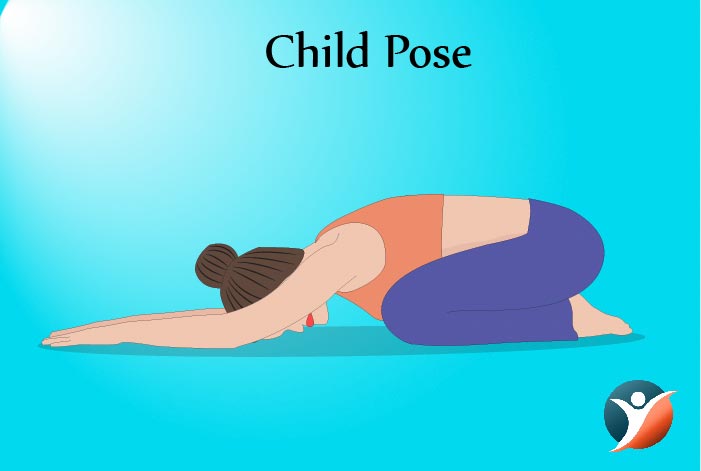
Child’s pose or Bal asana effectively reduces stress and induces a feeling of calmness. It gently stretches your thighs, hips and ankles. Child’s pose reduces fatigue and stress. Practising child’s pose will help you in getting rid of back pain that you might have developed due to prolonged sitting. As it can combat stress, it is one of the best yoga poses for diabetics.
How to do it:
- Sit on a yoga mat with your weight on your knees.
- Flatten your feet on-to the floor and sit on your heels.
- Spread your thighs a little apart.
- Exhale and bend forward from your waist area.
- Let your stomach rest on the thighs while extending your back.
- Stretch out your arms in the front to further straighten your back.
- You can also rest your head on the floor depending on your flexibility.
- You can breathe normally in this pose.
- Stay for as long as three minutes in this pose or less.
Tip: Avoid this pose, if you are pregnant, have diarrhea or a knee injury.
Image:
4. Sun Salutation (Surya Namaskar):
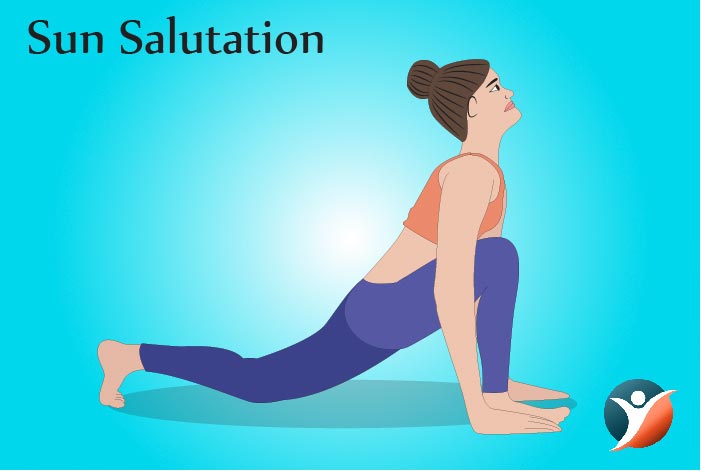
Sun salutation is a simple yet effective asana that includes 12 easy yoga poses in sequence. Surya Namaskar is extremely beneficial for people with diabetes as it helps in improving the blood circulation of pancreas and increases utilization of insulin. Let’s learn how to perform perfect sun salutations.
How to Do It:
4.1. Prayer Pose (Pranamasana):
- Stand still and look straight as you hold your hands together in a “namaste” pose.
- Keep your feet together while doing this pose.
4.2. Raised Arms Pose (Hastauttanasana):
- Inhale
- Stretch both your arms backwards while slightly bending to form a partial “C”
- Slightly expand your chest.
- Keep your feet closer while you do this pose.
4.3. Standing Forward Bend (Hasta Padasana):
- Exhale
- Bend forward to let your palms touch the floor.
- Keep your legs straight and face close to your knees.
- Keep your spine erect as you perform this asana.
4.4. Equestrian Pose (Ashwa Sanchalan asana)
- Inhale
- Stretch your left leg backwards and bend your right knee in a low-lunge.
- Place your arms parallel to your bended knee.
- Gaze forward as you watch straight while performing equestrian pose.
4.5. Staff Pose (Dandasana):
- Exhale out
- Now stretch your other leg backwards making a downward dog with your hands on yoga mat.
- Your hips must perfectly bend without excessive pressure on your back.
4.6. Eight-Limbed Pose (Ashtanga Namaskara):
- Bring your knees down to the floor.
- Rest your chest on the ground alongside with your palms.
- Exhale out
- Your toes must also rest on the floor with the tips. Observe that eight points of your body are actually touching the yoga mat ie. knees, chest, toes and palms.
4.7. Cobra Pose (Bhujangasana):
- Let your legs touch the mat as you slowly raise your upper body on your hands.
- Keep looking straight as you do this pose.
4.8. Downward-Facing Dog Pose (Adho Mukha Svanasana):
- Exhale,
- Lift your hips and lower body to make a downward-facing dog pose.
- Make sure that your palms and heels are touching the ground.
4.9. Equestrian Pose (Ashwa Sanchalan asana):
- Inhale,
- This time take your right leg backwards while placing your left arm parallel to the bent left knee.
- Gaze forward to perfect your Ashwa Sanchalan asana.
4.10. Standing Forward Bend (Hasta Padasana):
- Exhale
- Now it is time to stand again as you have done earlier in step-3 while simultaneously inhaling.
4.11. Raised Arms Pose (Hastauttanasana):
- Inhale
- Make Hastauttan asana pose as mentioned in step-2
4.12. Mountain Pose (Parvatasana):
- Look forward, join your hands in the classic “namaste” pose. Saying namaste would be a great idea.
- This mountain pose completes your sun salutation.
Tip: Avoid sun salutation if you are menstruating, have hernia, intestinal tuberculosis, high blood pressure or coronary artery disease
These easy steps might encourage you to do sun salutation several times each day for improved health and controlled blood sugar levels.
5. Triangle Pose (Trikonasana):
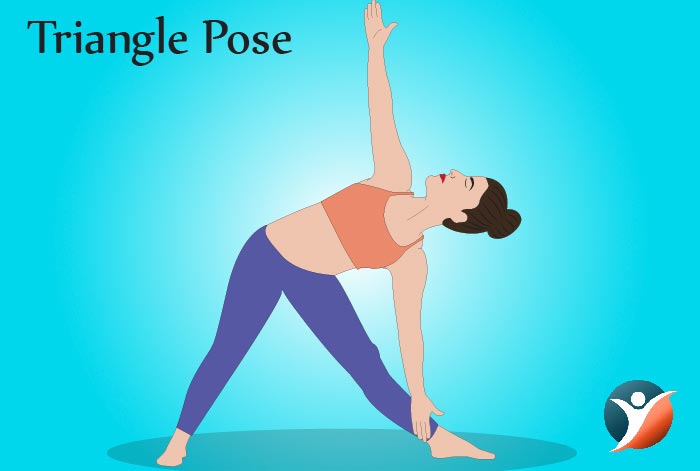
The triangle pose or Trikonasana is a great yoga pose to lose all that excess weight you carry around your stomach and waist. This is really an amazing yoga pose for people who are obese or overweight. Trikonasana also improves digestion, this makes this pose a boon for all the diabetics.
How to Do It:
- Stand straight and keep your both feet at-least three feet apart.
- Keep your right foot at 90 degrees while keeping your left foot is placed in at 15 degrees.
- Align the center of your right foot with the center of your left foot’s arch.
- Keep your feet pressed against the ground while maintaining your weight equally over boot foot.
- Inhale and as you exhale, bend your body from your hips to your right side.
- Ensure that your waist is straight.
- Lift your left hand upwards while your right-hand touches the ground.
- Both your hands should form a straight line.
- Your head could be in a neutral position or you can turn it to your left side gazing your left palm.
- Make sure your body is bent sideways and not forward or backward.
- Your pelvis and chest should remain wide open.
- Focus on stabilizing your body.
- Take deep breaths as you inhale and slightly relax your body as you exhale.
- Inhale and stand up gradually.
- Drop both your arms sideways and straighten your feet.
- Repeat the same pose with another leg.
Tip: If you have high blood pressure, don’t gaze upwards. You can look downwards in this case. While, if you suffer from diarrhea, headaches or low blood pressure; avoid this yoga pose.
6. Diamond Pose (Vajrasana):
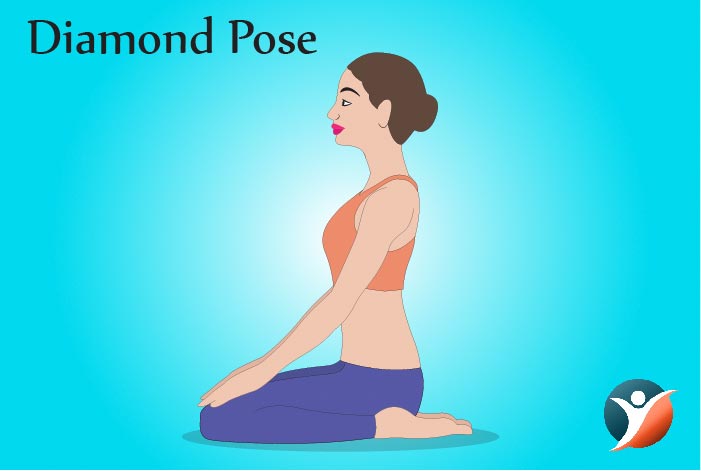
This is a simple pose which can calm your senses. It improves digestion, relaxes the mind and gently massages the kanda, which is a spot located around 12 inches above anus. Ayurveda believes in activation of kundalini, where the primal force of life resides according to Ayurveda. This kundalini can be activated by strengthening the kanda which lies at the bottom of our spine. It is a point where 72,000 nerves converge. Awakening kundalini stimulates the flow of energy in our body and keeps it in harmony. Vajrasana is indeed, a great pose for managing diabetes effectively.
How to Do It:
- Kneel on the yoga mat such that your heels are facing upwards.
- Gently place your hips on your heels.
- Make sure that both your heels are on either side of your anus.
- Place both your arms on your knees such that they are facing downwards.
- Close your eyes.
- Breathe deeply in this state.
Tip: If you are suffering from joint pain or spinal cord issues, you must avoid this pose.
7. Tree Pose (Vrikshasana):
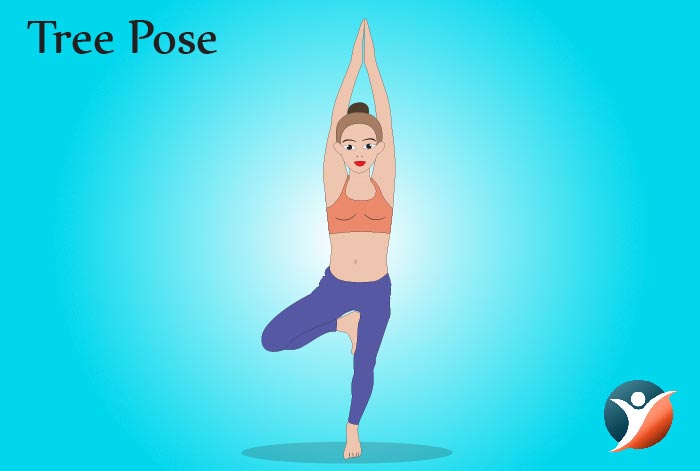
The tree pose or vrikshasana is one of the best asanas for diabetics. This yoga pose helps in improving the insulin secretion from the pancreas. So, get ready to pose like a tree leaving all your inhibitions behind.
How To Do It:
- Stand straight and drop both your arms on the sides of your body.
- Bend your right knee slightly.
- Place your right foot high up on your left thigh such that your sole is placed flat and firm on your thigh.
- Make sure your left leg is straight.
- When you are comfortable in this position, breath.
- Inhale,
- Raise your arms above you and make “namaste” position.
- Look forward and gaze something as this would help you in maintaining your balance.
- Keep your back straight while you do this pose.
- Inhale in deep breaths and relax your body every-time you exhale out.
- Slowly bring your hands down.
- Release your right leg.
- Repeat the process with left leg.
Tip: Avoid this pose, if you are suffering from insomnia or high blood pressure. In case you have high blood pressure, you should not keep your hands over your head for long time. Instead, hold your hands in “namaste” pose at the chest.
8. Plow Pose (Halasana):
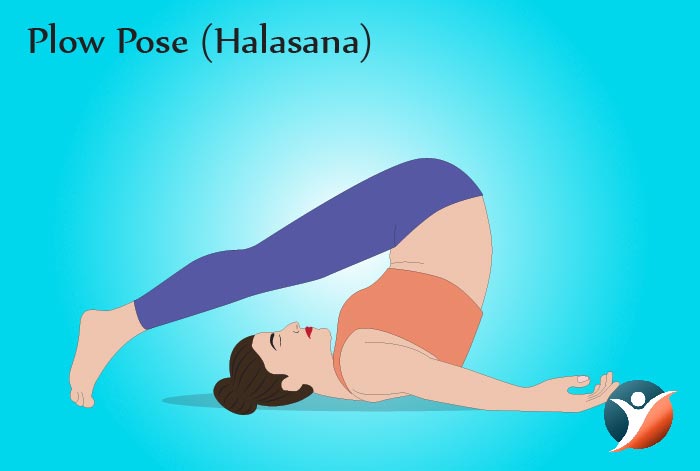
The plow pose or Halasana stimulates the parathyroid glands, thyroid glands, abdominal organs and lungs, thereby helping the blood flow towards your head. It also improves digestion and normalizes the hormonal levels.
How to Do It:
- Lie flat on your yoga mat.
- Place both your hands by your side.
- Bend your knees such that your feet are flat on the ground.
- Gradually raise your legs from hips and use your hands as support.
- Now, try to bend the legs at your hips and try to touch the surface behind your head, with your toes.
- Straighten your hands such that they lie flat on the mat.
- While you go up, inhale.
- Exhale as you gradually come down. Don’t come down suddenly.
- You can gently roll your back as you come down.
Tip: If you are suffering from hypertension, spleen or liver disorders, diarrhea, had a neck injury or are menstruating, avoid this pose.
9. Bow Pose (Dhanurasana):
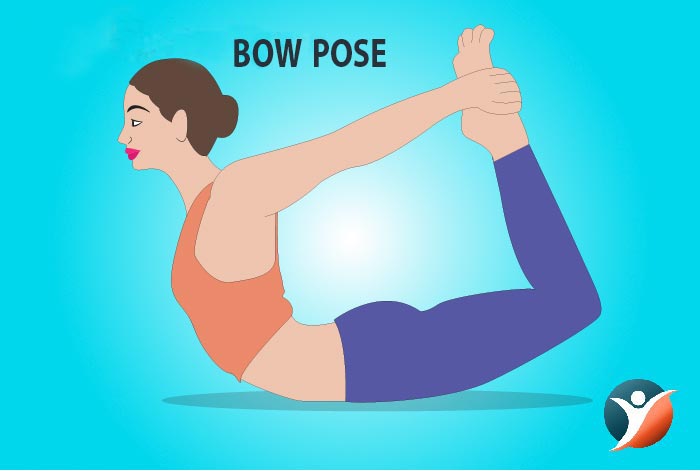
Bow pose or Dhanurasana can strengthen your spine and back. It also stimulates the reproductive organs, combats stress and reduces fatigue. Bow pose also relieves menstrual pain and relieves constipation. Another great yoga pose that can effectively reduce stress and help in managing diabetes.
How to Do It:
- Lie on your stomach with your feet hip-width apart.
- Your arms must be by the side of your body.
- Fold your knees and hold both your ankles with respective hands.
- Inhale as you lift your chest off the ground and pull your legs upwards.
- Look straight as you are in this position.
- Take deep breathes as you relax in this pose.
- Don’t overdo this stretch and relax after 15-20 seconds of holding this pose.
Tip: Avoid doing this pose, if you have high or low blood pressure, neck pain, pain in the lower back, migraine, are pregnant or had an abdominal surgery recently.
10. Reclining Spinal Twist (Supta Matsyendrasana):
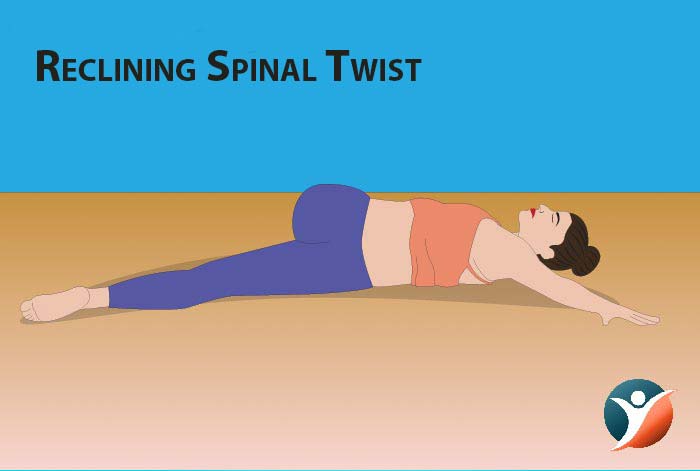
Reclining Spinal Twist or Supta Matsyendrasana is great pose to stretch your spine and relax muscles of your back. Moreover, Supta Matsyendrasana also helps in relaxing the mind and combating the stress. It is indeed one of the best yoga asanas for diabetics.
How to Do It:
- Lie on your back such that your arms stretched out in horizontal manner and in line with your shoulders.
- Bend your knees and bring your feet near to your hips.
- Make sure that the soles of your feet are completely on the ground.
- Swing your knees to the left side until your left knee touches the ground.
- Your right knee and thigh must rest on your left knee and thigh.
- Simultaneously, you should turn your head towards the right and gaze at your right palm.
- Ensure that your shoulder blades are touching the ground.
- While your body is in twisted state, one of your shoulder blades might lift off from the ground. You must work against this possibility to make it an effective stretch.
- Feel the stretch as you hold this pose.
- Relax deeper as you exhale out.
- After 3 to 4 minutes, you may gradually turn your head back to the center and straighten your body.
- Repeat this pose on the other side.
Tip: If you have any spinal injuries, avoid doing this pose.
11. Forward Bend Pose (Paschimotasana):
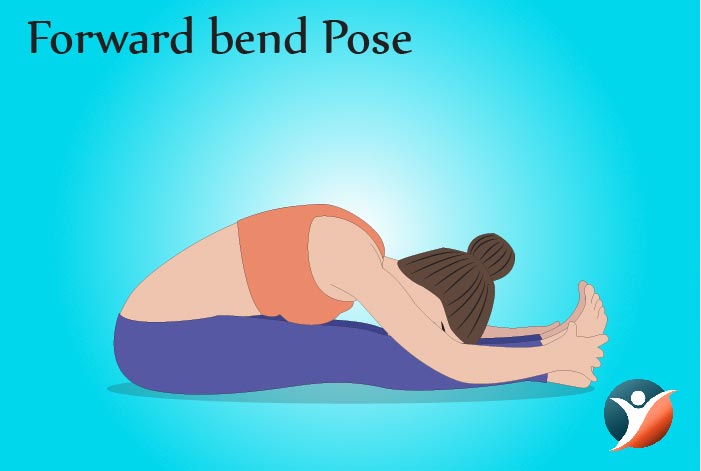
Paschimotasana is a forward bending pose which improves blood circulation towards the face. It also helps the stomach in functioning better. Forward bend pose also strengthens the thigh muscles and calms arms and back. Paschimotasana can help in reducing stress and is great for diebetics.
How To Do It:
- Sit with your legs stretched out on yoga mat.
- Hold the biggest toe of your feet with your thumb and index finger.
- Now, exhale
- Slowly bend forward and try to touch your knees by lowering your forehead.
- Make sure that your elbows touch the floor.
- Do not breathe in at this time.
- Hold this position for five counts.
- Inhale as you rise back to sitting position.
Tip: Avoid this pose if you have any kind of trouble in your spine or back.
12. Fish Pose (Matsyasana):
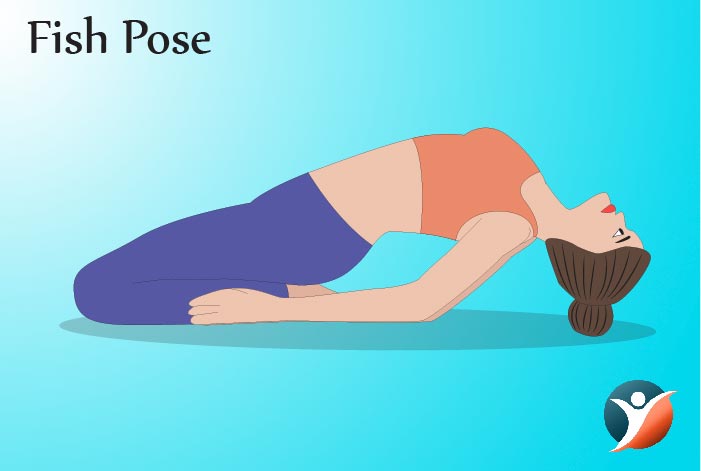
The fish pose or matsy asana is yet another powerful pose for managing and controlling your diabetes. It stimulates the pancreas and improves insulin secretion.
How to Do It:
- Lay on your back.
- Keep your legs very close together taking care that they don’t overlap.
- Keep your head under your torso, just near your glutes.
- Bring your hands as close as possible.
- Lift up your upper body such that your weight is resting on your elbows.
- Now, drop your head back.
- Your feet must be relaxed but close enough.
- Keep breathing and feel relaxed.
- Now, gradually lower your head and drop down your body.
- Relax as you keep your legs and hands apart.
Tip: Avoid fish pose if you are having abnormal blood pressure, migraine, spondylitis, neck injury, back pain, are pregnant or have general heart conditions.
13. Shoulder Stand Pose (Sarvangasana):
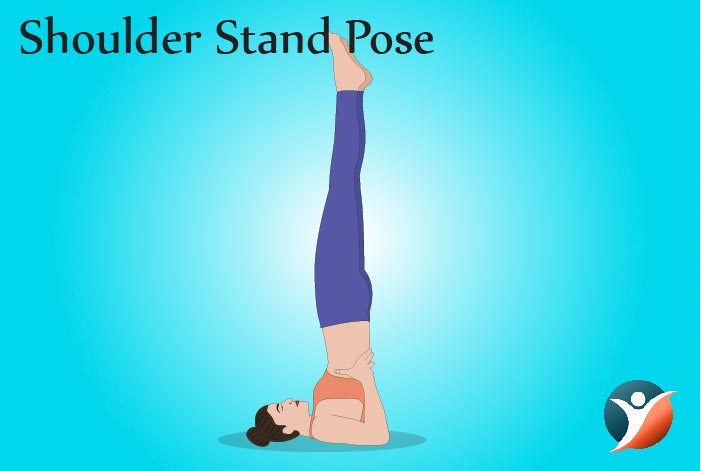
Shoulder stand yoga pose goes improves the digestive system, strengthens immune system, boosts metabolism and prevents nerve damage. All of this will eventually help you in managing diabetes and preventing its related complications.
How To Do It:
- Lie on the yoga mat.
- Now, lift your legs straight in forward direction by supporting the weight with your hands.
- Try to point your toes towards the ceiling such that all your weight should practically on your shoulders.
- Stay in this position as long you can stay.
- Get back to normal lying down position gradually.
Tip: Avoid this pose if you are suffering from any back problems or have high blood pressure.
14. Half Lord of the Fishes Pose (Ardha Matsyendrasana):
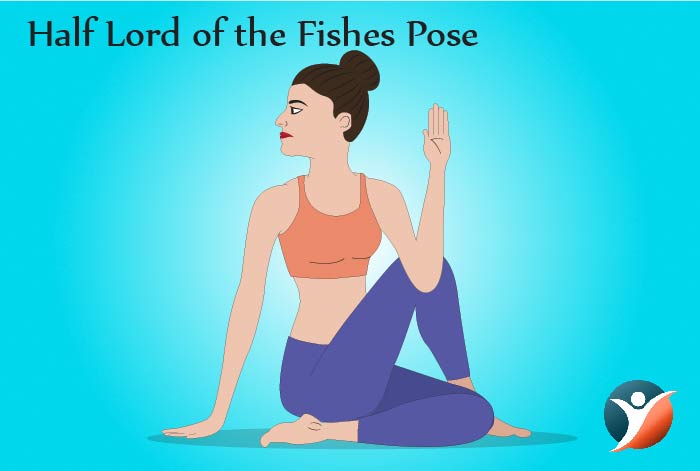
Half Lord of the Fishes yoga posture is also commonly known as the half twist pose. By eliminating out toxins from all crucial body organs including pancreas, gall bladder, liver, intestines; this half twist pose helps a lot in controlling diabetes.
How to Do It:
- Sit down and stretch your legs.
- Fold your right leg in such a way that the heel of your right leg must touch knee of your left leg.
- Keep your right hand at the back of your waist.
- Twist gently.
- Bring your left hand close to your right knee and hold ankle of this particular leg.
- Try to twist your head and shoulders when you are in this pose.
Tip: Avoid this pose if you are pregnant or are suffering from any heart, brain or abdominal injury.
15. Corpse Pose (Shavasana):

Shavasana or the corpse pose relaxes your whole body and releases stress, tension and anxiety. It also calms the muscles, stimulates blood circulation, reduces blood pressure and cures insomnia. With all these health benefits, it is an efficient yoga pose which can help in managing your diabetes. This pose is usually done at the end of your yoga practice for relaxation and rejuvenation.
How to Do It:
- Lie flat on your back just like you sleep.
- Legs should be placed a little wide apart.
- Keep your hands on your side and let your palms face upwards.
- Take rest.
- Close your eyes and breathe deeply.
- Start focusing from your head towards your feet.
- Make sure that you are deliberately resting your each body part.
- Practice it for 3-5 minutes or longer if you wish.
Tip: Avoid this pose if you have backache or suffer from acid-reflux.
Having discussed all these yoga asanas, it is advisable to be extremely careful while you perform few of the above-mentioned poses. You need to be particularly careful when you are suffering from any kind of neck pain, shoulder pain, or any other health issue. Avoid poses which might, in any way, harm your body.
Conclusion:
Yoga has been long known to both prevent and cure most of the illnesses. When yoga is practised regularly, it helps you in effectively controlling diabetes to a great extent. One of the primary causes of diabetes just like in the most other diseases is nothing but prolonged, excessive stress. Once you manage your stress, you would be in a better position to manage various debilitating conditions including diabetes.
Yoga calms the rattled nerves and senses of a person. It eventually creates a feeling of calmness and serenity. As a result, yoga is highly recommended by most of the medical experts all around the world. Yoga along with meditation can make you, a more confident person. Moreover, you can expect an almost normal life with diabetes.
You must now be aware of the various yoga poses which can help you in managing your diabetes. Even if you are a healthy person and not suffering from diabetes, it is advised that you adopt yoga as an integral part of your life. Did you enjoy reading our article?
Leave your comments and feedback below. We look forward to sharing many more yoga poses for a healthier and fitter you.




